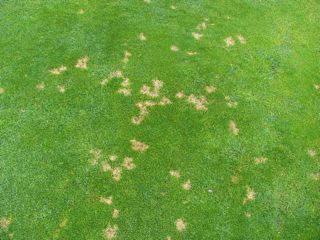User:Glenobear/Dollar Spot
Summary
[edit]Dollar spot is caused by the fungal pathogen Sclerotinia homoeocarpa. The pathogen blights leaf tissues but does not affect turf grass roots or crowns. The disease is a common concern on golf course turf, but is rare in sports turf and professional landscapes. Disease symptoms commonly result in poor turf quality and appearance. [1] The disease occurs from early spring through late fall, but is most active under conditions of high humidity and warm daytime temperatures (70-85°F) and cool nights in the spring, early summer and fall. The disease infects by producing a mycelium, which can be spread mechanically from one area to another. [2]
Hosts
[edit]Dollar spot is most commonly found on closely mowed turfgrasses. The pathogen infects most cool and warm-season grasses throughout the world, including creeping bentgrass (Agrostis stolonifera), annual bluegrass (Poa annua), Kentucky bluegrass (Poa pratensis), perennial ryegrass (Lolium perenne), hybrid bermudagrasses (Cynodon dactylon x tranvaalensis), seashore paspalum (Paspalum vaginatum), and zoysiagrass (Zoysia spp.) [3]
Symptoms
[edit]On fine textured and close-cut turf, the disease appears as round, brown to straw-colored and somewhat sunken spots approximately the size of a silver dollar. In coarse textured grasses maintained at taller cutting heights, the dead spots are larger and more diffuse. Spots are often seen in clusters. Dollar spot is readily distinguished from other turf disease by light-tan lesions with a reddish-brown border on the leaf blades of live plants near the edge of the affected area. On fine bladed grasses, the lesions usually girdle the leaf blade. Early in the day or in periods of extended dew, cobweb-like mycelium of the fungus can be seen growing on affected areas. During early stages of the disease, affected plants may appear water-soaked and wilted, but spots quickly fade to a characteristic straw color. [2] The mycelium found on foliage is often confused with that of Pythium, Nigrospora, and Rhizactonia. [3]
Disease Cycle
[edit]The pathogen overwinters and survives unfavorable periods as dormant mycelium on infected plants and plant debris. In addition to mycelium, dollar spot survives harsh environments as stromata on leaf surfaces. Apothecia occasionally are formed by the pathogen, but are sterile. Sexual spores have not yet been discovered in North America. [3]
Dissemination of the pathogen is restricted to the movements of infected leaf debris via equipment, people, animals, wind, or water. When environmental conditions become favorable for pathogen activity (warm, humid, high moisture in canopy), the dormant mycelia and stomata on the infected debris resume growing on the plant tissues. If moisture is sufficient in the turf canopy, mycelium can begin to penetrate new leaves and new host, causing infection. [3]
Environment
[edit]Prolonged periods of high humidity are required for the disease to infect, and infection may occur from late spring through late autumn. Conducive temperatures for dollar spot range anywhere between 59 and 86°F; different biotypes of the pathogen infect at different temperatures. Dew formation, which is driven by warm temperatures and high humidity levels during the day, followed by cool nights, enhances disease development. Dollar spot is more severe in dry soils, yet the disease requires high moisture in the turf canopy to thrive. Low nitrogen fertility can increase dollar spot susceptibility of the turfgrass. [3]
Management
[edit]Dollar Spot occurrence and severity can be minimized through cultural practices. By minimizing leaf wetness, the environment becomes less favorable for the pathogen to infect. Leaf wetness can be minimized by sound irrigation practices. Irrigation should be applied deeply and infrequently. Irrigation events should not occur in the late afternoon or evening, as this prolongs leaf wetness and may intensify disease. Removing dew and guttation fluids from the canopy can help lessen disease severity. This can be accomplished by mowing, rolling, "dew-whipping," or dragging a rope across the turf. Provide adequate air circulation by removing trees or installing large fans. Aerification and thatch removal are valuable tools; relieving compaction and thatch buildup allows the soil and canopy to dry more quickly. Light, frequent applications of nitrogen enhance the recuperative ability of the plant, allowing the turf to hide the symptoms of dollar spot and recover from any damage sustained. [3]
Newer cultivars of creeping bentgrass (Agrostis stolonifera) have been bred for dollar spot resistance. The National Turfgrass Evaluation Program conducts disease susceptibility trials, and results can be found at their website. [4]
Chemical control is an option for practitioners who need to maintain high quality, visual pleasing turfgrass. There are many fungicides labeled for control of Sclerotinia homoecarpa, although some biotypes of the pathogen have developed resistance to chemical groups including the benzimidazoles, dicarboximides, and sterol biosynthesis inhibitors. To slow or avoid the development of resistance, chemical classes should be rotated with each application. [3]
Importance
[edit]Dollar spot is one of the most economically important turfgrass diseases. It is the most common turfgrass disease in North America, with the exception of the Pacific Northwestern United States and Western Canada. [5]
Sources
[edit]- ^ http://www.extension.purdue.edu/extmedia/BP/BP-105-W.pdf
- ^ a b http://aggiehorticulture.tamu.edu/archives/parsons/turf/publications/Dollarspot.html
- ^ a b c d e f g Smiley, Richard W., Peter H. Dernoeden, and Bruce B. Clarke. Compendium of Turfgrass Diseases. 3rd ed. N.p.: The American Phytopathological Society, 2007. Print.
- ^ http://www.ntep.org
- ^ Couch, H.B. and J.R. Boom. (1960). The influence of environment on disease of turfgrass. II. Effect of nitrogen, pH and soil moisture on Sclerotinia dollar spot. Phytopathology 50:761-763.

